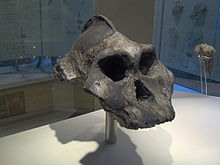Black skull
Black Skull ("black skull ") refers to a 2.5 ± 0.07 million year old fossil of Paranthropus aethiopicus , which was discovered in 1985 by Alan Walker west of Lake Turkana in Kenya . In the first scientific description by Alan Walker, Richard Leakey et al. the find was made to the species Australopithecus boisei . The fossil bears the archive number KNM-WT 17000 and is kept in the Kenyan National Museum (hence: KNM; WT stands for West Turkana).
The nickname "black skull" was given to the find because it had been stored for several hundred thousand years in a soil containing a lot of manganese , which is why manganese oxides were deposited in the course of the fossilization , which gave the fossil its bluish-black color.
KNM-WT 17000 comes from a full-grown individual and consists of his massive brain skull and the facial skull that is pulled far forward with the right 3rd premolar of the upper jaw preserved in situ . The soaring crest is also striking . Part of the skull is missing, and some fragments from the facial bones are missing. Overall, the conservation grade for a fossil of this age is unusually good, as Walker, Leakey et al. Discovered “no evidence of any plastic deformation” and that the skull capsule retained its “spheroidal shape”. It is also the only known skull of an adult Paranthropus aethiopicus . A volume of 410 cm 3 was calculated for the interior of the skull .
Already in the first description of the skull it was pointed out that the fossil had a much more distinctive overbite (the upper front teeth protruded significantly above the lower front teeth ) than all known fossils of the so-called robust australopithecines ; their tooth position should rather be described as largely orthognathic . Therefore, it cannot be ruled out that the assignment of the skull to Australopithecus boisei might have to be revised in the light of further finds. Possibly there is a relationship to the mandibular fragment Omo 18-1967-18, the type specimen of the species Paraustralopithecus aethiopicus , which was first scientifically described by Camille Arambourg and Yves Coppens in 1967 ; as a potential species name, Walker, Leakey et al. at the same time Australopithecus aethiopicus .
In fact, there was now an intensive scientific discussion of the family relationships of finds from the "robust" Australopithecines, which as early as 1987 resulted in a merger of the Black Skull , the lower jaw fragment Omo 18-1967-18 and some further bone fragments and teeth resulted in a new species, which was initially (and by some of the researchers still today) referred to as Australopithecus aethiopicus and later as Paranthropus aethiopicus .
literature
- Alan Walker, Richard Leakey, John M. Harris, Francis H. Brown: 2.5-Myr Australopithecus boisei from west of Lake Turkana, Kenya. In: Nature . Volume 322, 1986, pp. 517-522, doi : 10.1038 / 322517a0
See also
Web links
- humanorigins.si.edu : The fossil KNM-WT 17000 on the Smithsonian Institution website
Individual evidence
- ↑ Alan Walker, Richard Leakey, John M. Harris, Francis H. Brown: 2.5-Myr Australopithecus boisei from west of Lake Turkana, Kenya. In: Nature . Volume 322, 1986, pp. 517-522, doi : 10.1038 / 322517a0
- ^ Camille Arambourg, Yves Coppens: Sur la decouverte dans le Pleistocene inferieur de la valle de l'Omo (Ethiopie) d'une mandibule d'Australopithecien. In: Comptes Rendus des seances de l'Academie des Sciences. Volume 265, 1968, pp. 589-590

